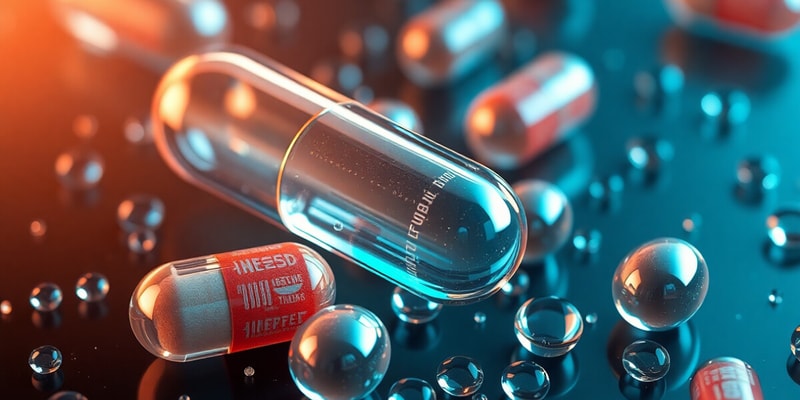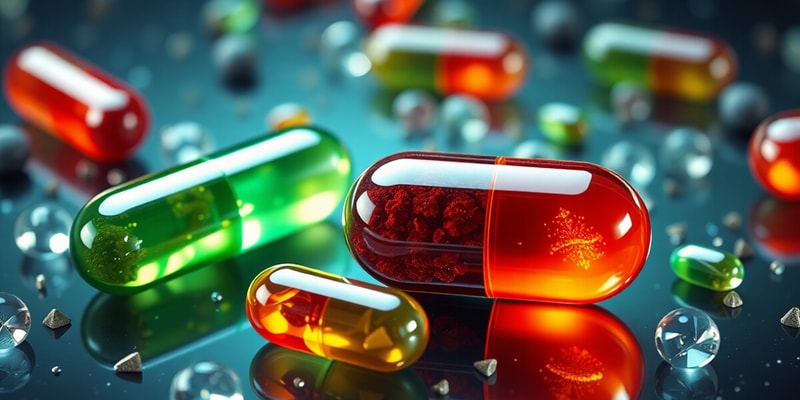Podcast
Questions and Answers
Gelatin is soluble in cold water.
Gelatin is soluble in cold water.
False
The moisture content in hard gelatin capsules typically ranges from 10% to 12%.
The moisture content in hard gelatin capsules typically ranges from 10% to 12%.
False
Gelatin capsules can absorb moisture from high humidity, affecting their shape.
Gelatin capsules can absorb moisture from high humidity, affecting their shape.
True
Imprinting is a technique used to fill gelatin capsules with liquid medication.
Imprinting is a technique used to fill gelatin capsules with liquid medication.
Signup and view all the answers
Hard gelatin capsules are not suitable for fixed or volatile oils due to stability concerns.
Hard gelatin capsules are not suitable for fixed or volatile oils due to stability concerns.
Signup and view all the answers
Gelatin is derived from hydrolysis of collagen obtained from animals' bones and skin.
Gelatin is derived from hydrolysis of collagen obtained from animals' bones and skin.
Signup and view all the answers
When exposed to moisture, gelatin capsules are prone to microbial decomposition.
When exposed to moisture, gelatin capsules are prone to microbial decomposition.
Signup and view all the answers
A drying material is often packaged with gelatin capsules to prevent moisture absorption.
A drying material is often packaged with gelatin capsules to prevent moisture absorption.
Signup and view all the answers
Manual filling capsule machines are not used in the production of hard gelatin capsules.
Manual filling capsule machines are not used in the production of hard gelatin capsules.
Signup and view all the answers
Gelatin capsules rapidly dissolve in cold gastric fluid.
Gelatin capsules rapidly dissolve in cold gastric fluid.
Signup and view all the answers
Study Notes
Definition of Capsules
- Capsules are solid dosage forms.
- The drug substance is enclosed in a water-soluble shell or envelope.
- Capsule shells are typically made of gelatin.
- Primarily intended for oral delivery.
- Capsules can also be administered rectally or vaginally.
Advantages of Capsules
- Drugs with unpleasant odors or tastes can be administered in tasteless capsules.
- Smooth texture, becoming slippery when moist, allows easy swallowing.
- Gelatin's ready solubility at gastric pH ensures rapid drug release in the stomach.
- Capsules are visually appealing.
- Capsules provide an accurate dosage.
- Capsules are generally tasteless and odorless when swallowed, unlike liquid medications.
- Shapes and colors, along with manufacturer's markings, help with capsule identification.
Disadvantages of Capsules
- Hygroscopic drugs cannot be encapsulated.
- Concentrated preparations requiring prior dilution are unsuitable for capsules, as they may irritate the stomach.
Types of Capsules
- Hard gelatin capsules
- Soft gelatin capsules
Gelatin
- Gelatin is a heterogeneous product created by hydrolyzing animal collagen (obtained from animal bones and frozen pork skin).
- There are two types of gelatin: Type A (derived from pork skin via acid treatment) and Type B (derived from bones and skin via alkaline processing).
- Differences in isoelectric points cause solubility variations at different pH values.
- Gelatin is stable when dry but can decompose when moist due to microbial activity.
- Gelatin is insoluble in cold water but dissolves in hot water and warm gastric fluids.
- Gelatin, being a protein, is digested by proteolytic enzymes and absorbed.
- Gelatin is non-toxic.
Hard Gelatin Capsules
- Used for administering solid medications.
- Consist of two parts: a body and a cap.
- Can be clear, colorless, and tasteless.
- Commonly colored with FD&C and D&C dyes.
- May contain combinations of colorants to improve identification.
- Normally contain 13% to 16% moisture.
- Capsules can become misshapen if exposed to high humidity.
- Capsules can become brittle in extremely dry conditions.
- Often packaged with a desiccant (e.g., silica gel) to prevent moisture absorption.
- Gelatin capsules are not suitable for aqueous liquids.
Constituents of Hard Gelatin Capsule Shells
- Gelatin: Creates the shell, protects contents, masks taste/odor.
- Plasticizers: Improve softness and elasticity (e.g., phthalates, glycerin).
- Preservatives: Prevent microbial growth (e.g., methyl paraben, sorbic acid).
- Solvents: Improve drug solubility (e.g., propylene glycol, PEG 400, ethanol).
- Darkening agents: Reduce transparency (e.g., titanium dioxide).
- Coloring agents: Enhance capsule appearance (e.g., FD&C and D&C dyes.)
- Flavors: Enhance taste and odor.
- Sugars: Add sweetness (e.g., sucrose).
- Acids: Reduce gelatin aldehyde tanning.
- Thickening agents: Adjust gelatin viscosity.
- Water: (a component in the manufacturing process.)
Capsule Number and Capacity
- Capsule sizes vary in capacity (e.g., 000-950mg to 0-100mg).
- Data exists relating number to approximate capacity.
Manufacturing of Hard Gelatin Capsules
- The process involves dipping, spinning, drying, stripping, trimming and joining.
- Diagrams show the stages of manufacturing.
Filling of Capsules
- Methods include:
- Punch method (bench-scale filling) for small quantities.
- Manual filling machine.
- Industrial-scale filling machines.
- Dependent vs Independent dosing systems with respect to measuring powder.
- Specific measuring devices for uniform powder distribution.
Capsule Handling and Quality Control
- Capsules may need to be polished to remove adhering powders.
- Cleaning techniques range from small-scale manual methods using gauze to industrial processes using vacuum cleaners.
- Additional techniques, like imprinting, can add branding to empty capsules.
- Special purpose capsules undergo unique treatments to alter solubility delays.
- Quality control tests include:
- Weight variation
- Content uniformity
- Disintegration
- Dissolution
Studying That Suits You
Use AI to generate personalized quizzes and flashcards to suit your learning preferences.
Related Documents
Description
This quiz explores the definition, advantages, and disadvantages of capsules as drug delivery systems. Capsules, primarily made from gelatin, are highlighted for their ease of swallowing and accurate dosage. Discover the unique properties and limitations of capsule formulations in pharmaceuticals.




